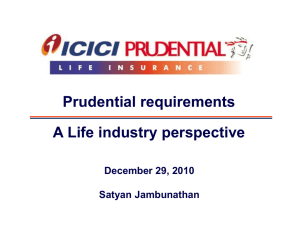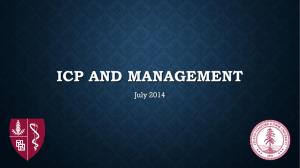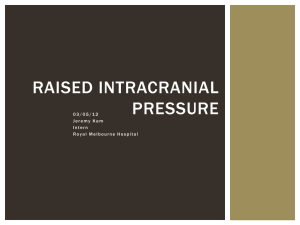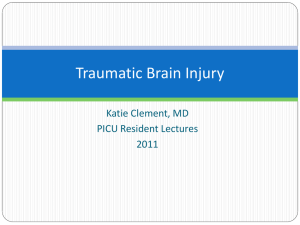Head Trauma
advertisement
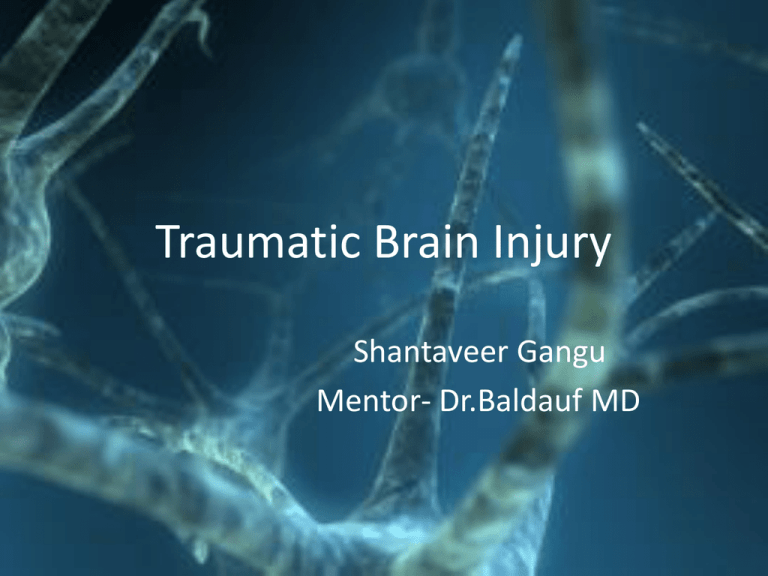
Traumatic Brain Injury
Shantaveer Gangu
Mentor- Dr.Baldauf MD
Demographics
• Account for 75% all pediatric trauma
hospitalizations
• 80% of trauma related deaths in children
• Domestic falls, MVA’s, recreational injuries
and child abuse account for majority of them.
• Gang and drug related assaults are on a rise.
• Firearm injuries to brain account for 12%
pediatric deaths.
Pathophysiology of Brain Injury
Brain Injury
Primary
2.Intracranial hypertension
and mass lesion
Secondary
1.Delayed cell death
3.Ischemia systemic
hypoxia,hypercarbia and
hypotension
Primary Brain Injury
@SITE
Focal
Primary
Diffuse
Contracoup
DAI
Cerebral Contusion
Most common Focal brain
Injury
Sites Impact site/ under
skull #
Anteroinferior frontal
Anterior Temporal
Occipital Regions
Petechial hemorrahges
coalesce Intracerebral
Hematomas later on.
DAI
Hallmark of severe
traumatic Brain Injury
Differential Movement of
Adjacent regions of Brain
during acceleration and
Deceleration.
DAI is major cause of
prolonged COMA after TBI,
probably due to disruption
of Ascending Reticular
connections to Cortex.
Angular forces > Oblique/
Sagital Forces
The shorn Axons
retract and are
evident histologically
as RETRACTION BALLS.
Located
predominantly in
1. CORPUS CALLOSUM
2. PERIVENTRICULAR
WHITE MATTER
3. BASAL GANGLIA
4. BRAIN STEM
Secondary Brain Injury
Biochemical Cascade
Blood Flow
changes(Global/regional)
AA/Neurotransmitter
release
Uncoupling of Substrate
delivery and extraction
CBF
Intracellular Ca++
accumulation and
cytoskeletal/ enzymatic
breakdown
Extracellular Cytokines and
GF
Generation of free radicals
CMRoxy
CMRglucose
External Compression
Intraparenchymal
Extraxial
(subdural/epidural)
OEF/GEF
Pneumocephalus
Depressed skull fracture
Initial Stabilization
• Initial assessment and resuscitative efforts
proceed concurrently.
Few things to watch for,
1.Airway
2.Cervical spine injury
3.Hypotension
4.Hypothermia
5.Neurogenic Hypertension
Cervical Spine X-ray: Lateral view. 1, Vertebral body (TH1). 2, Spinous process
of C7. 3, Lamina. 4, Inferior articular process. 5, Superior articular
process. 6,Spinous process of C2. 7, Odontoid process. 8, Anterior arch of C1
(Atlas). 9,Trachea.
Neurological Assessment
• Rapid Trauma Neurological Examination
1.
2.
3.
4.
5.
6.
7.
8.
9.
Level Of Consciousness
Pupils
Eom
Fundi
Extremity Movement
Response To Pain
Deep Tendon Reflexes
Plantar Responses
Brainstem Reflexes
Level Of Consciousness
• Glasgow Coma Scale
Eye Opening
Best Verbal
Best Motor
Spontaneous
4
Oriented
5
Obeys Command
6
To Voice
3
Confused
4
Localizes
To Pain
2
Inappropriate
3
Withdraws 4
None
1
Incomprehensible 2
Flexion
3
None
Extension
2
None
1
1
5
Children's Coma Scale
Ocular response
Verbal response
Motor response
Opens eyes spontaneously
4
Smiles, orientated to
sounds, follows objects,
interacts.
5
Infant moves spontaneously or
purposefully 6
EOMI, reactive pupils
( opens eyes to speech)
Cries but consolable,
inappropriate
interaction 4
Infant withdraws from touch 5
EOM impaired, fixed pupils
(opens eyes to painful stimuli)
2
Inconsistently
inconsolable, moaning
3
Infant withdraws from pain 4
EOM paralyzed, fixed pupils
( doesn’t open eyes)
1
Inconsolable, agitated
2
Abnormal flexion to pain for an
infant (decorticate response) 3
No verbal response
1
Extension to pain (decerebrate
response) 2
3
No motor response
1
Pupillary Exam
Pupillary size is
balance b/n
Sympath and
parasympathetic
influences.
Size, shape and
reactivity to light
are tested
parameters.
Mydriasis
Miosis
3 Cr.N. damageMydriasis
Carotid A. injury in
neck or skull base
Unilateral
mydriasis –
Transtentorial (
Uncal) Herniation
Horner’s
syndrome- Miosis
with Ipsilateral
ptosis and
anhydrosis.
Traumatic
iridoplegia
Hypothalamic,
cervicothoracic or
direct orbital
injury.
Seizure/ postictal
state
Atropine /
Sympathomimetics
Eye Movements
• SO4,LR6, All3
Injury location
Abnormality
Cavernous sinus/Sup Orbital fissure
All 3 Cr.N’s ( 3,4,6) are affected + V1
division
Transtentorial ( Uncal ) herniation
3 Cr.N
Raised ICP ( false localizing sign)
Isolated Abducens(6) palsy
Frontal eyes field ( brodman’s area 8)
Ipsilateral tonic conjugate deviation
Seizure involving frontal eyes field
Conjugate deviation to contralateral side
Occipital lobe injury ( unilateral)
Hemianopsia + ipsilateral conjugate gaze
preference
Brainstem Reflexes
Facial palsy unilateral
7 N injury- Basilar skull #
Corneal reflex ( V1+V2)
Rostral Pontine function
Dolls eye maneuver
Vestibuloocular function
Ice water caloric test ( never in awake
child)
COWS normal response
Coma – same side deviation
Stuporous/obtunded – nystagmus to
contralateral rapid component
Gag and cough reflex
9,10th N + brainstem swallowing centers
Periodic( Cheyne-stokes)
b/l hemispheric/diencephalic injury to as
caudal as upper pons
Apneustic ( prolonged ispiratory plateau)
Mid- caudal pons injury
Ataxic breathing( irregular stuttering
resp)
Medullary respiratory generator center.
Deep tendon and superficial reflexes
• DTR’s exaggerated after TBI due to cortical
disinhibition
• Decreased / absent after Spinal cord injury
• Asymmetric DTR’s unilateral brain/spine injury
• Superficial lost/decreased in corticospinal
dysfunction and helpful in localizing lesions
• Plantar response
Normal reflex
Intact descending corticospinal inhibition
Positive Babinski
Interrupted inhibition pathways
Neurodiagnostic Evaluation
Skull Radiograph
Controversial usage, costs> benefits
CT
Contiguous slices from vertex to foramen
Magnum.
Extend to C3 if upper spine # suspected
Brain, Blood and Bone windows
May miss # that run parallel to CT slice and
located at vertex.
Indications controversial, a must in
1.Penetrating head trauma
2.basilar/ depressed skull #
3.Posttraumatic seizure
4.Severe head injury
In addition anyone with,
1.Altered level of consiousness
2.Focal deficits
3.Persistent headaches/ repeated emesis
MRI
Better than CT in subacute and chronic phases of
injury to detect contusions/shearing in white
matter/c.callosum
Invaluable in spinal cord injury
Cerebral angiography
Carotid/vertebrobasilar dissections/occlusions
Pesudoaneurysms
Clinical Features In Head Trauma
•
•
•
•
•
•
•
Scalp Injuries
Skull Fractures
Depressed Skull Fractures
Basilar Skull Fractures
Vascular Injuries
Penetrating Head Injury
Intracranial Hemorrhage
–
–
–
–
Epidural Hematoma
Subdural Hematoma
Subarachnoid Hemorrhage
Intracerebral Hemorrhage
Scalp Injuries
• Most are laceration
– Simple Linear/ Stellate ED Rx
– Extensive, Degloving/Avulsion Repair GA
– Overlying Depressed Skull#, Infections
Repair+ Elevation Of #
– Hematomas
Subgaleal
Cephalohematomas
Galeal Apo & Periost
Periost & Skull
Cross Suture Lines
Limited By S.Lines
Hypotension & Anemia(bp,hct)
Calcify And Disfiguring Sx
Skull Fractures
• Thin skull #’s common place.
• Risk of # associated intracranial injuries?
• CT to R/o
1. Open
2. Closed
3. Linear (3/4)
4. Comminuted ( multiple branches)
5. Diastatic ( edges split apart)<3yrleptomeningeal
cyst, cephalomalacia,
6. Depressed
7. Basilar
Depressed Skull #
• From focal blow
• Closed 10% FND/15% seizures Rx, for
cosmetic reasons
• < skull thickness- no elevation
• Open/ frontal sinus intracranial wall elevate
and Sx + frontal sinus irrigation
• Free floating – remove/replace wrt size and
after soaking in abx
Basilar Skull #
Basilar
Petrous
Bone
Longitudinal
Cribriform
Plate
Transverse
Rhinorrhea
Epidural Hematomas (EDH)
• Peak incidence in 2nd decade
• Source meningeal vessel, Dural venous
sinus, diploic vein from skull #
• H/o minor head injury Viz fall
• C/f wrt size, location, rate of accumulation
– Lucid interval (33%), non specific
– Confusion, lethargy, agitation, focal neurological
deficits.
Diagnosis
• CT is diagnostic
• Initial Ct Hyperdense Lentiform collection
beneath skull
• Actively bleeding- Mixed densities
• Severe anemia- isodense/hypodense
• Untreated EDH imaging over days
Hyperdense Isodense Hypodense w.r.t.
brain
Treatment
Non surgical
Minimal / no symptoms
Should be located outside of Temporal or
Post fossae
Should be < 40 ml in volume
Should not be associated with intradural
lesions
Should be discovered 6 or more hours
after the injury
Surgical
Subdural Hematoma
• Common in infants.
• Cause high velocity impact/ assault/ child
abuse/ fall from significant height.
• Associated with cerebral contusions + DAI
• Source cortical bridging veins/ Dural
venous sinuses.
Adults
Child/infants
Cerebral convexities over frontal/
temporal regions
Occipital + Parietal cortex
Parafalcine ( post falx cerebri),
supratentorial
{ abuse}
50% are unconscious
immediately.
Focal deficits common
Hemiparesis – 50%
Pupillary abnormality- 28-78%
Seizures – 6-22%
Rx- larger- urgent removal
Small Small with mass effect/
significant change in
conscious/ focal deficits
Removed
Small with significant brain
injuries + mass effect out of
proportion to size of clot
Non operative approach
SDH’s are High density
collections on CT
conforming to convex
surface of brain
Cant cross falx cerebri/
tentorium cerebelli {
compartmentalized}
Can cross beneath suture
lines
Distorstion of cortical
surface/ effacement of
ipsilateral ventricle/ shift
of midline often noted.
SAH
• Trauma is leading cause.
• Acute from disruption of
perforating vessels around
circle of Willis in basal
cistern
• Delayed from ruptured
pseudo aneurysm.
• Rx maintain intravascular
vol to prevent ischemia
from vasospasm.
• Mortality 39% { national
traumatic coma databank}
Intracerebral • CT- hyperdense/mixed
Bleed
• MRI- small petechial bleed+
Rare in Peds.
60% from small contusions
coalesce to form larger
hematoma.
Rarely , violent angular
acceleration bleed in deep
white matter, basal ganglia,
thalamus
Transtentorial Herniation
midbrain bleed ( Duret
hemorrhages)
Common sites
Ant Temporal and Inf Frontal
lobes { impact against lateral
sphenoid bone/ floor of ant
fossa}
DAI
• Rx- small- non operative.
Resolve in 2-3 weeks
• Large- Sx drainage.
• Repeat CT in small bleeds
after 12-24 hr is warranted
to r/o coalescence to form
large hematoma.
Penetrating
Head Injury
Infants and children fall on sharp objects with
thin skull and open foraminae could predispose
for these injuries.
R/o child abuse
Rx Surgical.
Entry wound debrided and FB removed with in
driven bone fragments.
Peri and post op ABX
Prophylactic anticonvulsants
Adolescents and children Gun Shot Wounds. (
12%) and increasing annually.
Higher mortality when
1.Low GCS on presentation (3-4)
2.B/L hemispheric /brainstem injury/
intraventricular tracking
3.Hemodynamic instability/ apnea/both
4.Uncontrolled ICP.
• CT- localizes bullet and
bone fragments
• MRI- non advised till
magnetic properties of
bullet known.
• Rx. Surgical
– Debridement of entry
and exit wounds
– Remove accessible bullet
and bone
– Control hemorrhage
– Repair Dural lacerations
+ closure of wounds.
– NO ATTEMPT TO
REMOVE BULLET OR
BONE BEYOND ENTRY
AND EXIT WOUNDS.
Intracranial Hypertension
• Pathophysiology
– ICP monitoring and control are the cornerstones of TBI
management
– Normal ICP
• Adults <10mmhg
• Children 3-7mmhg
• Infants 1.5- 6mmhg
– When to treat?
• Adults > 20
• Children >15
• Infants >10 { Arbitrary numbers most commonly used,
pending outcome studies}
CBF Autoregulation
CPP = MAP- ICP { mmhg}
Normal Brain
• CBF maintained within CPP
range of 50-150mmhg as vessels
can expand / constrict
accommodate p changes.
•<50 CPP maximal Dilation
occurs CBF falls as CPP drops
•>150CPP maximal Constriction
occurs CBF raises with CPP
TBI
• CBF falls b/n 50-80 mmhg of
CPP Range of Hypo perfusion
•Auto regulation may be ,
1. Completely lost linear
relation B/n CBF & CPP
2. Incompletely lost Plateau
after CPP of 80 mmhg
Monro-Kellie doctrine – Vol
of intracranial compartment
must remain constant
because of inelastance of
skull
Normal State- ICV is a balance b/n
Blood, brain & CSF.
With ICSOL ICP remains normal till
compensation can occur
At the Point of decompensation The
ICP starts to increase.
The brains compensatory reserve is
called Compliance
Measure of compliance
1.Volume pressure response
2.Pressure Volume Index ( PVI)
=
V/ LOG P1P2
Transient elevation in ICP
Lundberg Waves
1. A wave
Duration = 2-15 min
Amplitude = 50-80mmhg
Results from
Transient occlusion of venous
outflow as bridging veins
occlude against compressed
dura. Or transient vasodialtion
and hence increase CBF as a
response to ischemia
Sustained A waves may indicate
sustained elevation in ICP and
hence low brain compliance
2. B waves changes in ICP w.r.t.
Ventilation
3. C waves short lived waves
w.r.t. arterial Traube-Herring
waves
Shape of ICP wave form as
an indicator of Compliance
Normal ICP has 3 wave forms.
1.Percussion wave- first and
highest amplitude wave
2.Dicrotic wave – second
wave
3.Tidal wave- third and lowest
amplitude
In reduced brain compliance
the Dicrotic and Tidal waves
augment exceeding the
percussion waves.
ICP measurement
Intraventricular Cath coupled to
ICP transducer is Gold standard.
Which patients need ICP
monitoring??
1.TBI + abnormal CT scan who are
not following commands ( 5063%)
2.Comatose + Normal CT had
lower risk ( 13%) unless
associated with
1. Older age
2. Systemic Hypotension ,
<90mmhg
3. Motor posturing, with
these risk is upto 60%
3.Most clinicians use abnormal CT
scan result + low GCS scores ( < 8)
as candidates for ICP monitoring
Device / method
Risk / benefit
1. Intraventricular catheter
Adv- drainage of CSF to reduce ICP
DisAdv- infection/ ventricular
compression leads to inaccuracy
2. subdural/ subarachnoid bolts
( Philadelphia, Leeds, Richmond bolts)
Occlusion of port in device leads to
inaccuracy
3. Fiberoptic cath ( Camino labs)
Improved fidelity & longevity
Can be placed Intraparenchymal/
intraventricular/ subdural
Used to drain CSF
Accuracy maintained even with fully
collapsed ventricles
Single cath can be used as long as needed
Non invasive ICP measurement
Ultrasonographic tech
Pediatr Crit Care Med 2010 Vol. 11, No. 5
Audiological tech- displacement of TM
and perilymphatic pressure as a correlate
of ICP
Infrared light- thickness of CSF from
reflected light as a correlate of ICP
Arterial BP wave contours and blood flow
velocity – mathematical model
Changes In optical nerve head with
optical coherent tomography
IOP as correlate of ICP
With ICP cutoff of 20mmhg it has
Specificity of 0.7 and sensitivity of 0.97
Mangement of ICP
• Goal to maintain CPP by
– Reducing ICP, and/or
– Increasing MAP { hyper/normo volumia preffered as opposed
old school Hypovol}
Brief periods of hypotension can double the mortality rates
CPP should be match with cerebral metabolic demand to avoid
hypoperfusion / hypeeperfusion.
Cerebral OEF is helpful as,
Decrease in CBF increase OEF increase AvDo2 fraction
AvDo2= diff b/n O2 content of Arterial – jugular mixed venous
blood.
Considering Ao2 as constant, venous O2 alone can solely be
assessed.
Normal svJo2 is 65%, a drop to 50-55% global cerebral ischemia
Hyperdynamic therapy
•
•
•
•
•
•
To maintain CPP of about >70, by increasing MAP
{ CPP= MAP-ICP}
IVF- crystalloid/colloid
PRBC if low HCT(<30%)
Pressors as needed ( Dopa, Dobu,Phenylephri)
if autoregulation is intact? incres CPP
vasoconstriction constant CBFless volume
reduction in ICP.
• Systemic Hypo ? Vice versa
Increasing CPP by reducing ICP
Sedation and pain control
Fentanyl/ midazolam drip
Etomidate in initial phase
Quiet envir + min extern stimuli
Pharmacological paralysis if needed
Increase in Pneumonia+ sepsis
IV/ ET lidocaine ( ET > IV)
During intubation, before ET suctioning,ET
manipulation
Elevation of head end by 20-30deg
Red venous press ICP
Can cause orthostatic changesfall
CPP rebound ICP rise
Excessive PEEP, tight cervical collar, neck
flexion/ rotation
Can rise ICP
Bladder distention rise
Contin drainage
Occult seizures unexplained rise
Prophylactic Anticonvulsants
Fever rise
Rx + hypothermia.
Specific measures to reduce ICP
Hyperventilation
Rapid & effective response.
Red Paco2/incr pH vasoconstricton
Red CBF
Disadvantages
1.paco2 < 30 torr red CBF to ischemic
level
2.Regional variation in autoreg
hyperventilation induced reverse vascular
steal
Current recommendations
1. routine hypervent ( 35 ) not be used in
first 24 hrs
2.Chronic hypervent be avoided in
absence of documented ICP rise
3.Reserved for deterioration not
responding to other measures.
4.When needed with caution, PaCo2
never <30 torr.
5.svJo2 can be used as indicator of
extreme ischemia( CBF fall)
6.If used, withdrawn slowly to avoid
rebound rise
• CSF drainage- effective and safe.
• Provides gradient for bulk flow of edema fluid
from parenchyma of brain to ventricles.
• Continous – 5-10 torr gradient
• Intermittent for 1-5 min when needed.
Diuretics
Mannitol – works as osmotic diuretic
extract extra and intra cellular edema
fluid from brain
Disadv- may preferentially affect normal
areas ( intact BBB) vs affected zones (
disrupted BBB)
Additional mech reduces blood
viscocity ( by hemodilution) and improves
Rheology Increas CBF vasocons
decreas volume red ICP.
3 dosing methods
• intermittant boluses when ICP 15-20
•Intermittant Q6 hrly
•Continous infusion
Risks
1. Repeated dose reduced osmotic
gradient
2. Hyperosmolar state ( serum osm>320
mOsm) renal failure,
rhabdomyolysis, hemolysis
• Steroids – No role currently in TBI
• Barbiturates- usually last resort med.
Pros
Cons
Reduce ICP , CBF, CMRO2
Inhibit free lipid
peroxidation reduce cellular
damage
Close ICU monitoring
Hypotension
Hyponatremia
Myocardial depression
ALGORITH for
treatment of elevated
ICP with severe head
injury.
( Brain trauma
Foundation, American
Association of
neurological Surgeons,
Joint section of
Neurotrauma and
critical care)
Bispectral Index
• Bispectral index (BIS) is one of
several recently developed
technologies which purport to
monitor depth of anesthesia.
• Uses ,
1. Monitor depth of anesthesia
2. Reduce incidence of
intraoperative awareness
3. Monitor recovery from brain
injury
4. With ICP to monitor during
therapeutic burst suppression.
5. 0-100 scale.
6. 40-60 good depth of
Anesthesia.
POST TRAUMATIC SEIZURES
• Complicate 10% pediatric head injuries
1. Impact seizures follow minor injury ,
occur on impact
2. Early posttraumatic seizures within min
to hours of injury.
1. No radiological intracranial injury
noted in many cases
2. Do not portend later epilepsy
3. Most do not need Rx
4. Outcome good.
•
Late seizure >24 hrs after injury
– Visible intracranial injury.
– Penetrating injuries/ depressed #/
SDH/ Lower GCS score
– Long term risk of epilespy high- need
Rx for 6-12 mo.
• Seizure prophylaxis
Only during first week Or till
intracranial hypertension
phase is passed.
Prolonged usage has cognitive
deficits on long term follow
ups.
Phenytoin commonly used
Thank You



